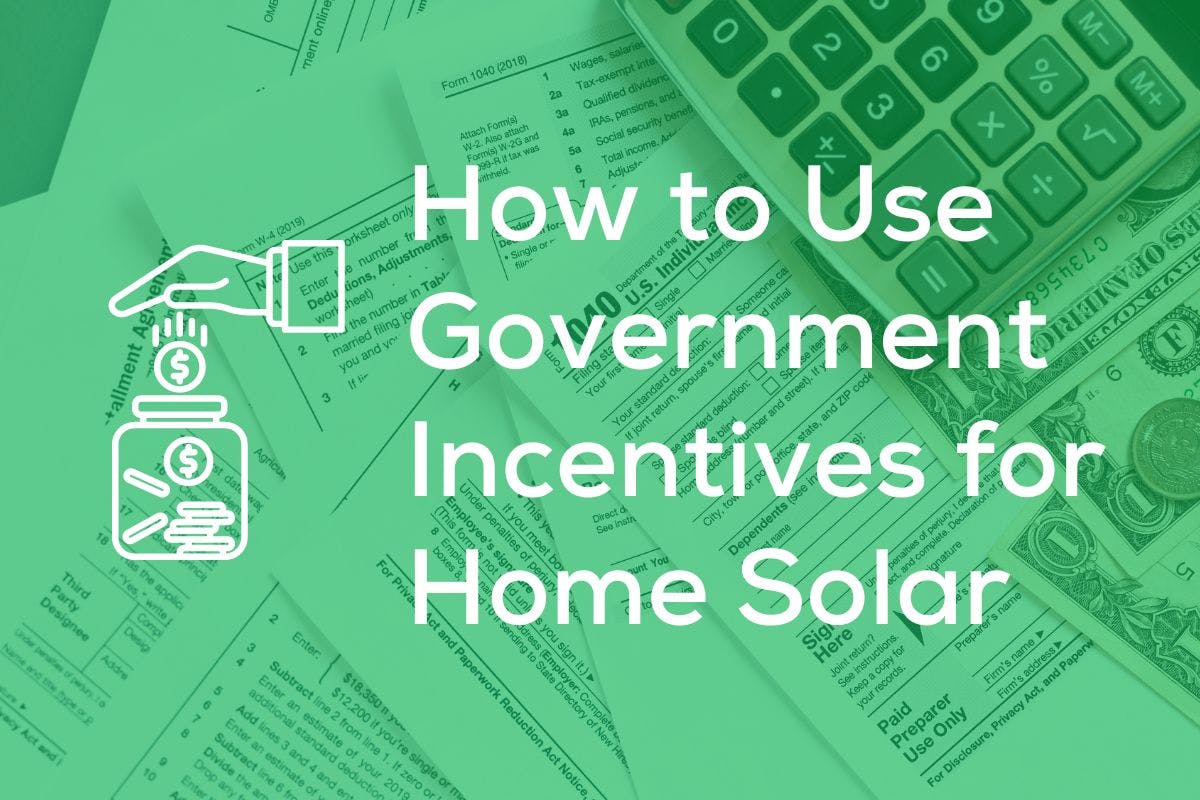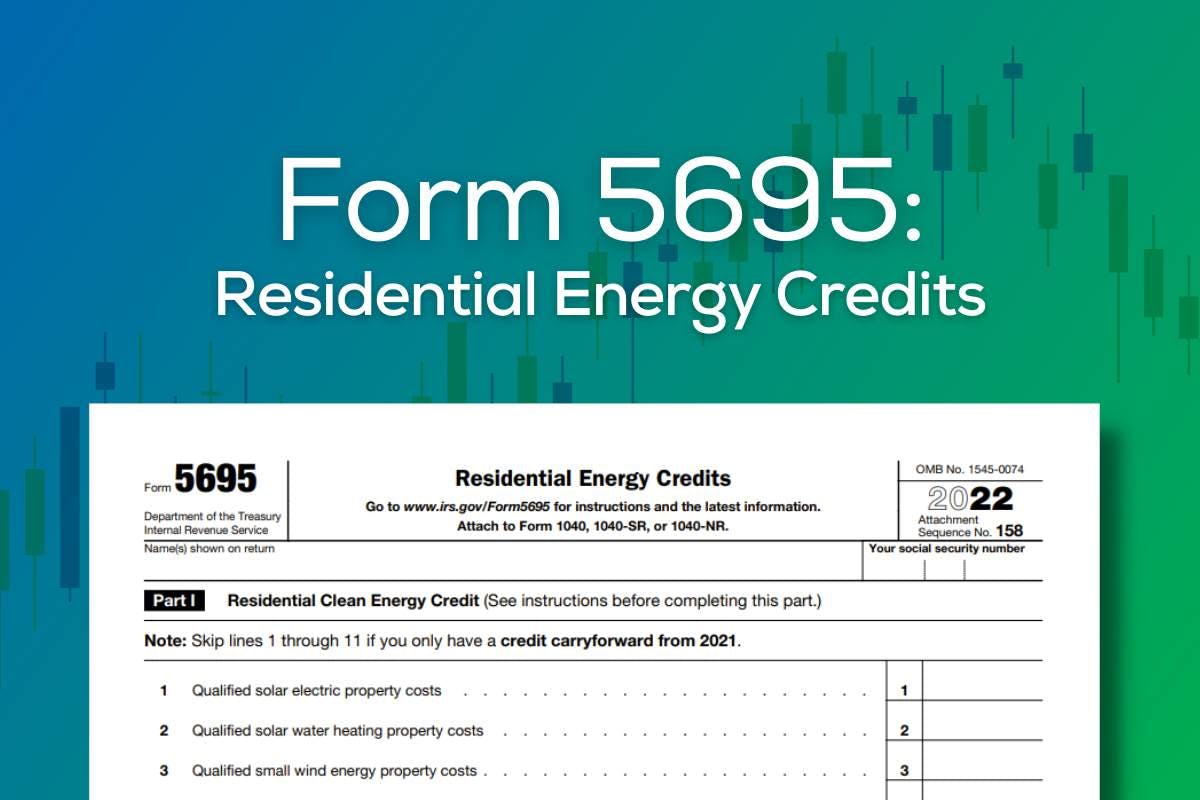Government Incentives for Solar Energy: How They Can Help You Save
Last edited

Author
Andrew Giermak
Solar and Electrification Writer and Editor

Editor
Andrew Blok
Electrification and Solar Writer and Editor

Saving money and making the best long-term investment possible are critical parts of deciding to go solar for home energy. Government incentives from federal income tax credits down to perks at the local level can make a substantial difference in the upfront expenses of home solar panels and the solar payback period you can expect with a new system.
Here’s what you need to know about tax credits, rebates, and programs like net metering that can help you maximize your savings when you go solar.
See how much you can save by going solar with Palmetto
Government Incentives for Solar Energy in the US
The number of home solar panels installed in the US has been steadily increasing since around 2010, according to the Solar Energy Industries Association.

Credit: SEIA
This growth is largely thanks to government incentives, technological improvements, and a maturing marketplace that enables homeowners to access affordable solar energy system installations.
Of course, there is always change with growth, and government incentives are constantly appearing, disappearing, and transforming. With this in mind, no matter where you live or when you read this, here are a few steps you can take to maximize government solar incentives for your green energy upgrade.
1. Identify which incentives are available for your solar installation.
2. Determine whether or not you qualify for the programs or benefits.
3. Work with a professional to streamline processes and maximize your savings.
Federal Solar Tax Credit
The federal solar tax credit, formally known as the Residential Clean Energy Credit, can be utilized by those who purchase and install a solar energy system at their primary residence.
The RCEC can be redeemed as a tax credit against federal income taxes, equal to 30% of solar energy system project costs. In other words, this credit is not a cash rebate. It offsets personal income tax liability.
So even though there will not be a check in the mail, the federal solar tax credit can significantly cut the total expense of a new solar system. Since its introduction in 2006, the federal solar tax credit has aided countless homeowners in going solar with savings on solar panels and energy storage systems.
After an extension from the Inflation Reduction Act of 2022, the RCEC is currently available at 30% of system cost through 2032. Then, the value is set to gradually decline starting in 2033 and 2034 before ultimately expiring in 2035. If your credit is larger than your tax liability for one year, you can claim it in portions over multiple years.
Consult your own tax advisor and resources from the IRS to see how the RCEC applies to your situation.
State Tax Credits
Just as the federal government offers a personal income tax credit for those who purchase solar energy systems, several state governments have followed suit.
State tax credit programs for solar are somewhat scarce. Where available, total credit limits vary and are also typically based on the total costs of your installation.
For example, if you were going solar in Arizona, you may be eligible for a state income tax credit worth 25% of installation costs up to a maximum value of $1,000. This credit could then be applied to your state income tax liability separately but in the same year as the federal RCEC.
In New York, there is a state income tax credit of 25% up to a maximum value of $5,000. Hawaii has a state income tax credit of 35% up to $5,000.
State Property Tax Exemptions
In 2025, 36 states have policies that exempt all or some of the value of a solar energy system from property tax assessments. These policies prevent your property taxes from rising as a result of going solar so as not to penalize you for a renewable energy upgrade.
On the other hand, if you purchase solar panels and decide to sell your home, the value of your renewable energy system may increase its market price.
State Sales Tax Exemptions
Like with property taxes, solar energy systems are also exempt from sales taxes in 25 states.
Sales tax exemptions take slightly different forms state by state and may not always apply to every aspect of a solar installation.
Net Metering and Renewable Energy Certificates
Net metering, net billing, and renewable energy certificate programs vary by state and even by utility company.
These policies fall under the umbrellas of “feed-in tariffs” or “solar generation incentives,” involving how local utilities compensate solar energy system owners for the electricity they produce and share with the grid.

Credit: DSIRE via SEIA
So although net metering policies may not be considered an official government incentive for solar energy, they are a very important part of the financial calculation for homeowners owning solar panels. Net metering policies are mandatory in some states and can incentivize home installations by making them more valuable.
In short, the rates at which your utility credits you for the solar power you generate will always depend on government policy. In most states, these net metering or net billing regulations are controlled by public utility commissions.
See how much you can save by going solar with Palmetto
Local Green Energy Rebates and More
After exploring federal and state government incentives for solar energy, it’s time to go local.
Towns, cities, and counties across the US incentivize residents for offsetting greenhouse gas emissions with clean electricity generation. Often, this will come in the form of a one-time rebate at a value based on the size of the solar panel system.
To find the solar energy policies, incentives, and rebates available in your area, we recommend using the Database of State Incentives for Renewables & Efficiency (DSIRE) from the North Carolina State University Clean Energy Technology Center. Or, you can visit your local resources directly, including city and state government websites.
Determine if You or Your Solar Energy System Qualifies
Solar incentives are often geographically specific. Knowing this, the next time you read something promising unbeatable incentives, verify they are legitimate and available for your exact property.
A few other factors could impact your qualification for government-sponsored solar incentives.
- Equipment: Residential solar incentives are usually for permanent installations that power your home. Single-use solar devices can electrify exterior lights or charge your phone on the go, but these small-scale products will rarely qualify for substantial government incentives.
- System design: How your solar energy system operates with the grid will determine which government incentives you can leverage. For example, some rebates are exclusively available for grid-tied solar panels and cannot be redeemed for off-grid solar energy systems.
- Purchasing decisions: You may not qualify for certain incentives (like the federal tax credit) if you do not own your energy system. With that said, if you decide to lease solar panels or opt for a power purchase agreement (PPA), your provider may reduce your total contract expenses by passing along savings from commercial solar incentives. Palmetto’s LightReach Energy Plan lets you get home solar panels without the upfront cost.
- Opportunity to save: Lastly, several solar incentives may only be valuable to those with other expenses that need to be offset. For instance, the federal solar tax credit can only reduce your personal income tax if you have a tax liability in the first place.
The Financial Impact of Government Incentives for Home Solar
To illustrate the impact of government incentives, let’s walk through the immediate and long-term savings you could earn on your solar panel installation with multiple incentives from federal and local government programs.
Let’s say you:
Live in Illinois and own your home. Want to install a 9 kW solar energy system. And have a total project cost of $28,000.
As a homeowner and taxpayer, you may be eligible for the residential clean energy credit. At 30% of total project costs, this could translate into a federal income tax credit worth $8,400.
Getting a bit more local, if you are a ComEd (Commonwealth Edison) customer, you may be eligible for a distributed generation (DG) rebate worth $300 per kW of solar energy installed. In this case, a 9 kW installation could earn a solar rebate equal to $2,700.
So, in reality, your $28,000 investment in solar energy may look more like $16,900 after government incentives. Then, after your system is installed, you can let the savings begin while the solar power generated on your property lowers your ongoing energy bills.
In this Prairie State example, you could be eligible for Illinois Shines, a program that lets you sell the solar renewable energy credits (SRECs) your system will produce in advance. This can help drive down the cost of your solar installation even more.
What to Do if You Don’t Qualify
If you do not qualify for the federal solar tax credit, this does not mean your renewable energy journey has to end. Likewise, if financing doesn’t fit your budget after looking at solar incentives in your state, there may be other options available to go green and save on utility bills.
The Palmetto LightReach Energy Program eliminates upfront costs for homeowners and can enable savings on energy costs in the first year.
Maximizing Incentive Benefits
If you qualify for one or more solar incentives or programs, you want to ensure you will receive the maximum benefits.
First, follow the correct steps and timeline with any incentive program. Missing due dates could disqualify you from an incentive altogether. Working with a professional can help you keep everything on track and check every box.
Remember the RCEC can be claimed over multiple years. If your tax liability is too small to claim it all at once, you can claim it in portions.
With tax credits, tax exemptions, and other programs across the country, federal and local government policies are making solar energy more financially accessible for homeowners today.
Navigating the Solar Incentive Landscape with a Professional
Usually, incentives can be redeemed after an installation has been completed, so it is important to determine the programs for which you will qualify before signing your solar contract.
So, before you go solar, be sure to ask your installer and your tax expert whether you will qualify for tax credit and other incentives or programs.
Federal income tax credits will most likely be claimed when you do your annual filing (with Form 5695 for the RCEC). Other rebates and incentives will have their own separate documentation and requirements.
Interested in going solar? To see how much you can save, you can use Palmetto’s home solar savings calculator.
See what solar can do for you:
Frequently Asked Questions
How does the federal solar tax credit work?
The federal solar tax credit applies for anyone who purchases, with cash or a loan, and installs a solar energy system at a primary residence. It is a tax credit on federal income taxes equal to 30% of the system and installation cost. It is a credit to a taxpayer’s income tax liability, not a rebate or refund.
Is there a federal solar rebate for solar?
There is not a federal solar rebate program. Some states, localities, and utility companies have rebate programs for solar or battery storage.
How do I find the solar incentives available to me?
Information on state and local programs can be found at sites such as the Database of State Incentives for Renewables & Efficiency (DSIRE) or on utility company websites. The IRS has information on the Residential Clean Energy Credit. You can also reach out to Palmetto and our expert team will help you at each step of going solar.
How much is a solar panel system for a 1,500 square foot house?
The size of a home is one of many factors in getting a good estimate of the cost of a new home solar system. A very broad range of a 4-6 kW system for a 1,500 sq. ft. home is $12,000-$22,000 before incentives. The best way to answer this question is by getting a quote from a reputable solar company.
Disclaimer: This content is for informational purposes only. All content mentioned does not constitute professional advice and is not guaranteed to be accurate, complete, reliable, current, or error-free. Palmetto does not provide tax, legal, or accounting advice. Please consult your own tax, legal, and accounting advisors.




